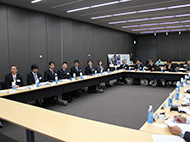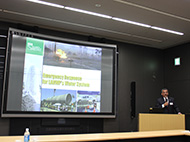Events
KOBE Workshop on International Research, Development, and Implementation in Water System for Disaster Prevention & Preparedness
Date: November 15, 2012
Venue: 1F Conference Room, #4 Bldg., Kobe City Hall
Organized by:
Kyoto University Global COE Program “Global Center for Education and Research on Human Security Engineering for Asian Megacities”
Co-organized by:
Kobe City Waterworks Bureau
Number of attendants: more than 35
Report 229
Outline
‘KOBE Workshop on International Research, Development, and Implementation in Water System for Disaster Prevention & Preparedness’ was held at 1F Conference Room, #4 Bldg., Kobe City Hall on November 15th, 2012. The objectives of this
workshop are the followings:
1. To share our experiences of 1994 Northridge Earthquake and 1995 Kobe Earthquake.
2. To exchange the achievements of international research on water system for disaster prevention and preparedness.
3. To recognize the effectiveness of countermeasures against earthquake; ER-Joint
pipe.
4. To exchange the system for installation of ER-Joint pipe.
5. To establish the international network between LADWP, WaterRF, and Kobe Waterworks Bureau.
In the morning session, five presentations and discussions on international collaborative research opportunity are conducted. In the afternoon, we have a site-visit to a construction site of ER-Joint pipe, emergency water supply station, and large capacity water main in Kobe.
Report
In the first session, Mr. Castruita had a presentation on the emergency response for LADWP’s water system. He indicated that using lessons learned would be significant for response measures. Ms. Cline presented lessons from 2005 Hurricane Katrina and 2012 Hurricane Sandy, and their preparing for disaster in United States. She pointed out that reduction of gaps in emergency planning is significant for water utilities. Mr. Hashigami made a presentation on 1995 Kobe experience and their improvement of water system after 1995 earthquake. In his presentation, water system seismic resilience requires comprehensive and advanced earthquake resistant measures.
Then, Assoc. Prof. Hirayama introduced the framework of international research for disaster prevention in water system. Mr. Sakaki had a presentation on comprehensive evaluation procedure for seismic strategies in Kobe. Dr. Davis presented quantifying post-earthquake potable water system services based on his research activities. We would agree on the international cooperative research between United States and Japan for more resilient water system.
In the afternoon session, we visited to Kobe Water Quality Management Center and had a tour of 1995 Kobe earthquake damaged pipes. Also we visited a construction site of ER-Joint pipe, emergency water supply station, and large capacity water main in Higashinada, Kobe. We discussed on an organized scheme for implementation of successful technologies.



